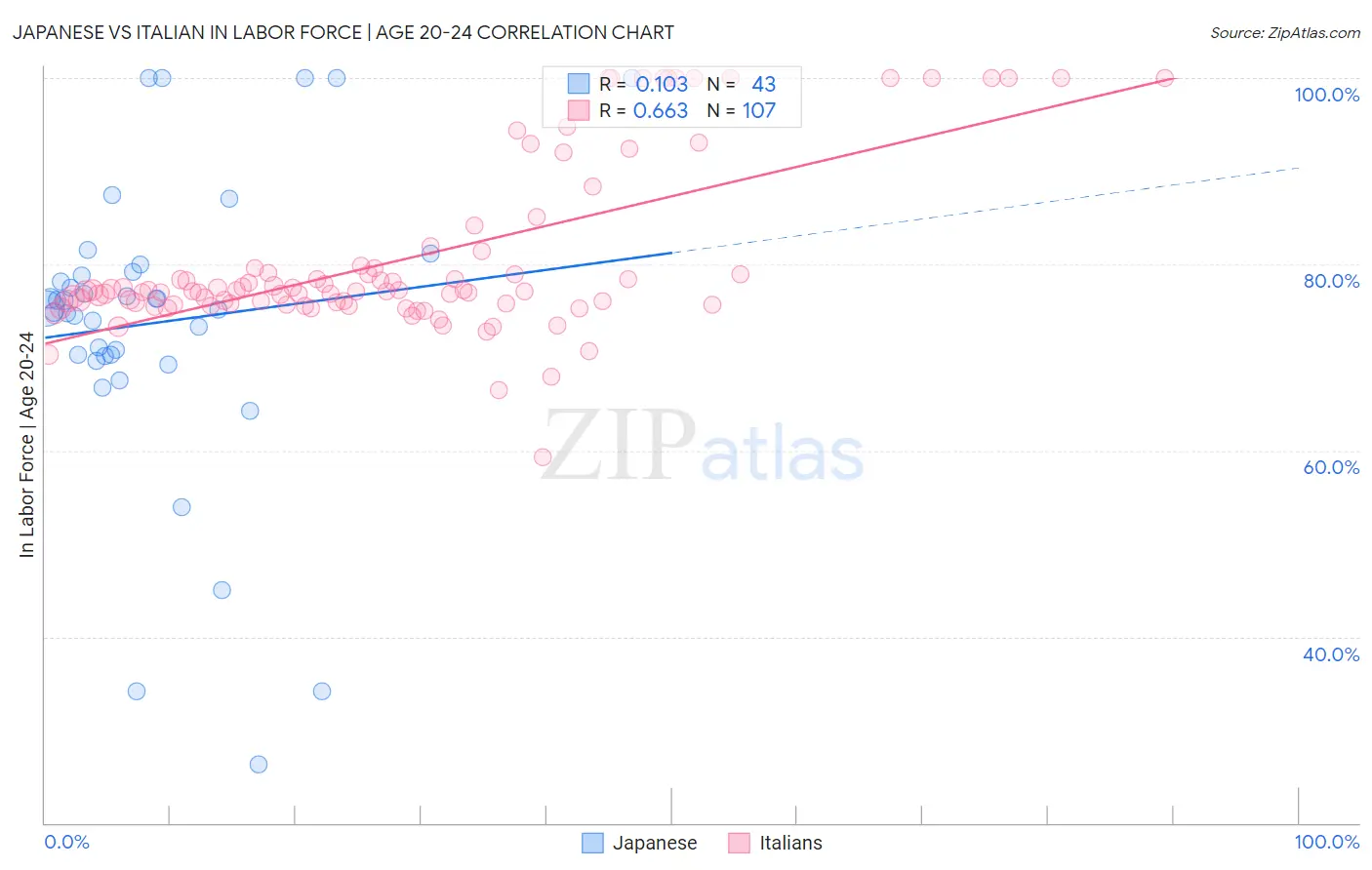Japanese vs Italian In Labor Force | Age 20-24
COMPARE
Japanese
Italian
In Labor Force | Age 20-24
In Labor Force | Age 20-24 Comparison
Japanese
Italians
75.3%
IN LABOR FORCE | AGE 20-24
68.7/ 100
METRIC RATING
160th/ 347
METRIC RANK
76.5%
IN LABOR FORCE | AGE 20-24
99.6/ 100
METRIC RATING
80th/ 347
METRIC RANK
Japanese vs Italian In Labor Force | Age 20-24 Correlation Chart
The statistical analysis conducted on geographies consisting of 249,162,424 people shows a poor positive correlation between the proportion of Japanese and labor force participation rate among population between the ages 20 and 24 in the United States with a correlation coefficient (R) of 0.103 and weighted average of 75.3%. Similarly, the statistical analysis conducted on geographies consisting of 573,427,196 people shows a significant positive correlation between the proportion of Italians and labor force participation rate among population between the ages 20 and 24 in the United States with a correlation coefficient (R) of 0.663 and weighted average of 76.5%, a difference of 1.7%.

In Labor Force | Age 20-24 Correlation Summary
| Measurement | Japanese | Italian |
| Minimum | 26.3% | 59.3% |
| Maximum | 100.0% | 100.0% |
| Range | 73.7% | 40.7% |
| Mean | 73.7% | 80.5% |
| Median | 75.3% | 77.1% |
| Interquartile 25% (IQ1) | 70.1% | 75.7% |
| Interquartile 75% (IQ3) | 79.2% | 79.6% |
| Interquartile Range (IQR) | 9.1% | 3.9% |
| Standard Deviation (Sample) | 16.2% | 9.1% |
| Standard Deviation (Population) | 16.0% | 9.0% |
Similar Demographics by In Labor Force | Age 20-24
Demographics Similar to Japanese by In Labor Force | Age 20-24
In terms of in labor force | age 20-24, the demographic groups most similar to Japanese are South American Indian (75.3%, a difference of 0.010%), Immigrants from Bolivia (75.3%, a difference of 0.040%), Immigrants from El Salvador (75.3%, a difference of 0.050%), Immigrants from Western Europe (75.3%, a difference of 0.050%), and New Zealander (75.2%, a difference of 0.050%).
| Demographics | Rating | Rank | In Labor Force | Age 20-24 |
| Guatemalans | 72.3 /100 | #153 | Good 75.3% |
| Osage | 72.3 /100 | #154 | Good 75.3% |
| Immigrants | Guatemala | 71.9 /100 | #155 | Good 75.3% |
| Immigrants | El Salvador | 71.7 /100 | #156 | Good 75.3% |
| Immigrants | Western Europe | 71.5 /100 | #157 | Good 75.3% |
| Immigrants | Bolivia | 71.0 /100 | #158 | Good 75.3% |
| South American Indians | 69.0 /100 | #159 | Good 75.3% |
| Japanese | 68.7 /100 | #160 | Good 75.3% |
| New Zealanders | 65.4 /100 | #161 | Good 75.2% |
| Immigrants | Romania | 64.6 /100 | #162 | Good 75.2% |
| Costa Ricans | 64.2 /100 | #163 | Good 75.2% |
| Bolivians | 64.0 /100 | #164 | Good 75.2% |
| Afghans | 63.5 /100 | #165 | Good 75.2% |
| Cambodians | 60.5 /100 | #166 | Good 75.2% |
| Immigrants | South Eastern Asia | 57.5 /100 | #167 | Average 75.1% |
Demographics Similar to Italians by In Labor Force | Age 20-24
In terms of in labor force | age 20-24, the demographic groups most similar to Italians are Basque (76.5%, a difference of 0.020%), Hmong (76.5%, a difference of 0.020%), Immigrants from Zaire (76.6%, a difference of 0.030%), Immigrants from Cameroon (76.6%, a difference of 0.050%), and Canadian (76.6%, a difference of 0.050%).
| Demographics | Rating | Rank | In Labor Force | Age 20-24 |
| British | 99.8 /100 | #73 | Exceptional 76.7% |
| Cree | 99.7 /100 | #74 | Exceptional 76.6% |
| Immigrants | Middle Africa | 99.7 /100 | #75 | Exceptional 76.6% |
| Immigrants | Moldova | 99.6 /100 | #76 | Exceptional 76.6% |
| Immigrants | Cameroon | 99.6 /100 | #77 | Exceptional 76.6% |
| Canadians | 99.6 /100 | #78 | Exceptional 76.6% |
| Immigrants | Zaire | 99.6 /100 | #79 | Exceptional 76.6% |
| Italians | 99.6 /100 | #80 | Exceptional 76.5% |
| Basques | 99.5 /100 | #81 | Exceptional 76.5% |
| Hmong | 99.5 /100 | #82 | Exceptional 76.5% |
| Carpatho Rusyns | 99.4 /100 | #83 | Exceptional 76.5% |
| Austrians | 99.4 /100 | #84 | Exceptional 76.5% |
| Portuguese | 99.3 /100 | #85 | Exceptional 76.4% |
| Immigrants | Iraq | 99.3 /100 | #86 | Exceptional 76.4% |
| Immigrants | Thailand | 99.3 /100 | #87 | Exceptional 76.4% |